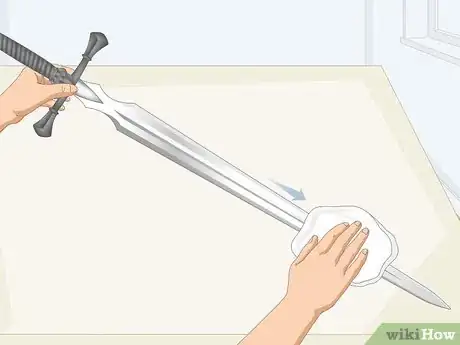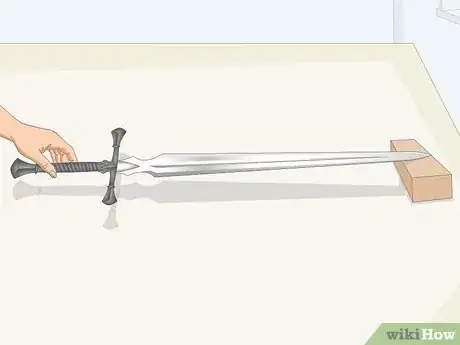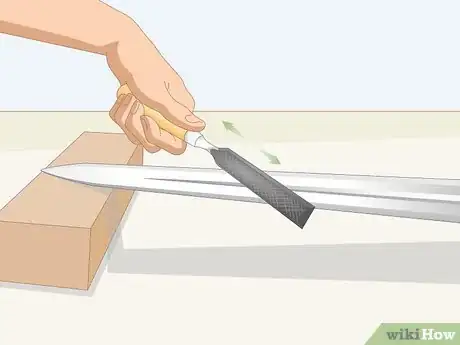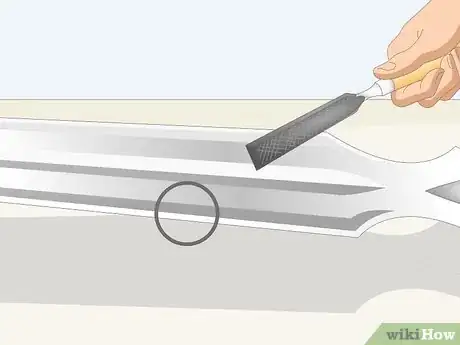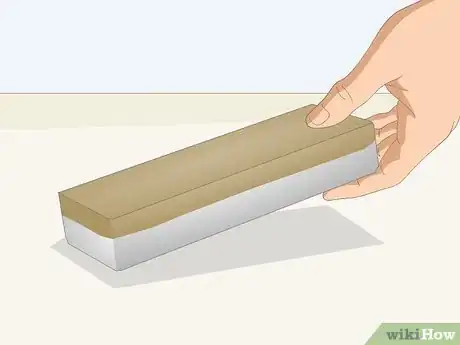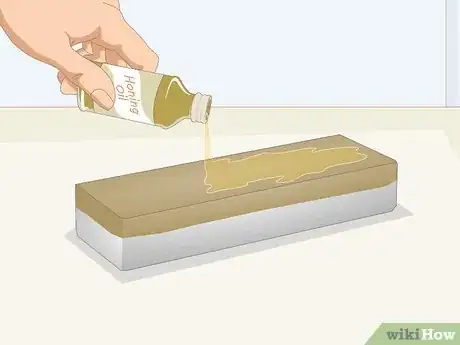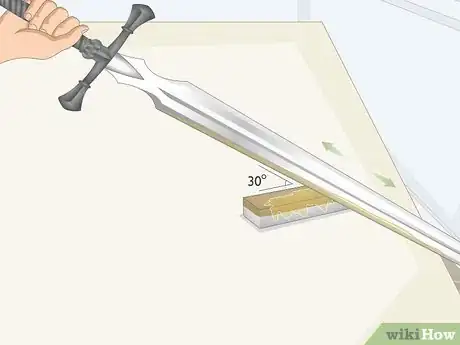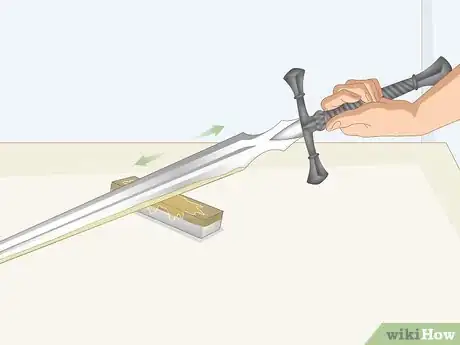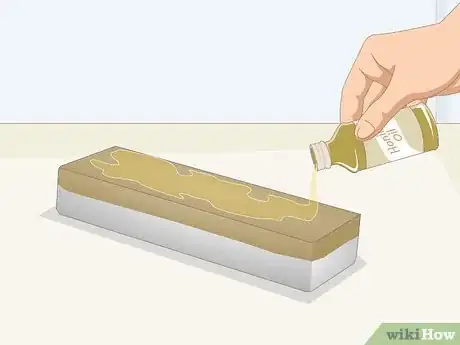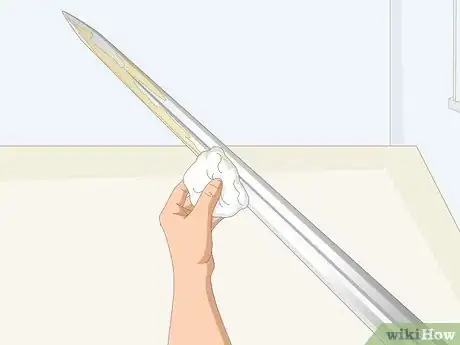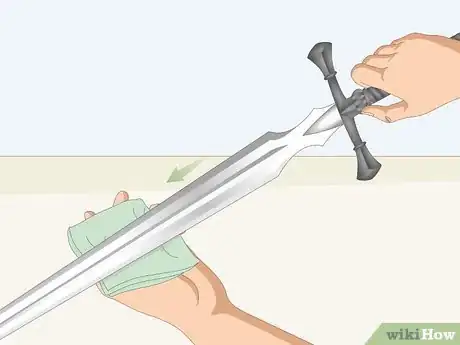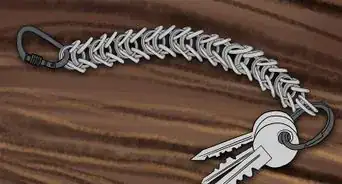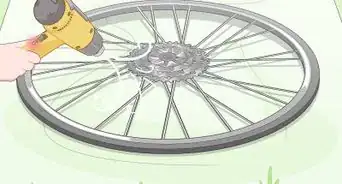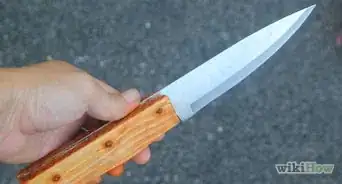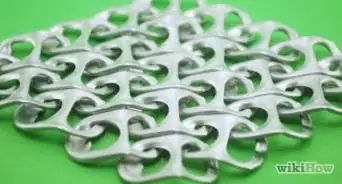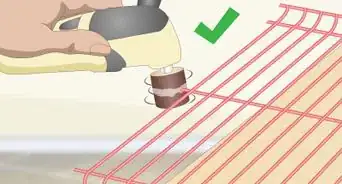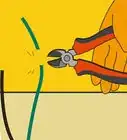This article was co-authored by wikiHow Staff. Our trained team of editors and researchers validate articles for accuracy and comprehensiveness. wikiHow's Content Management Team carefully monitors the work from our editorial staff to ensure that each article is backed by trusted research and meets our high quality standards.
There are 8 references cited in this article, which can be found at the bottom of the page.
wikiHow marks an article as reader-approved once it receives enough positive feedback. In this case, 87% of readers who voted found the article helpful, earning it our reader-approved status.
This article has been viewed 99,399 times.
Learn more...
Collecting swords and other edged weapons is popular among hobbyists. But over time, any sword's edge will begin getting dull and require a sharpening. This seems like an intimidating job, but it just takes some practice. With a metal file, a sharpening stone, and some oil, you can keep your blade looking like new.
Steps
Filing the Blunt Edge
-
1Wipe down the sword with a rag. This removes any dust, oil, or residue on the blade that could get in the way of the sharpening process.[1]
- Be extremely careful during this step because one wrong move could cut you. Pay close attention to what you’re doing and run the rag up the blade very gently. Don't apply pressure.
-
2Lay the sword on a table with the blade propped up. Use a block of wood to elevate the blade and make it easier to work on. Place this block under the blade near the tip of the sword.[2]
- This table should be completely stable. Fix any wobbling before you start working on your sword.
- Make sure there is plenty of light in the area so you can see what you’re doing and avoid cuts.
Advertisement -
3File the blade at a 30-degree angle. Use a metal file and apply even strokes to one side of the blade. Run the file up the blade smoothly and maintain this 30-degree angle. This filing should gradually shape an edge on the blade.[3]
- Depending on the length of the blade, you can divide the blade into ½ or 1/3 sections and focus on each section individually. After filing both sides, continue to the next section.
- Keep your fingers safely away from the sword blade to avoid cuts. Pay attention so you always know where your fingers are relative to the blade.
-
4Alternate sides of the blade regularly. Filing is meant to form a rough edge on the blade. For an even edge, both sides of the blade require equal work. Keep close track of your strokes. Switch sides after every few strokes to ensure both sides get an even filing.[4]
- It helps to count your strokes and switch after a certain amount. For example, you could count 10 strokes on one side, then flip the sword and count 10 on the other side.
-
5Stop filing when an edge appears. The filing process shaves metal away and reveals the natural edge in the sword. The edge will be very rough at this point, but don’t worry. You’ll sharpen it later on. Right now, it’s important that the blade develops a discernible and even edge.[5]
- Don't test your blade for sharpness at this point. It hasn't been fully sharpened yet and needs further work.
Sharpening the Blade on a Whetstone
-
1Use a medium-grit sharpening stone. Sharpening stones, or whetstones, come in a wide variety of grit levels ranging from very coarse (200 or below) to extremely fine (8000). A medium grit, around 1000 to 1500, should cover most normal sharpening needs.[6]
- A very coarse grit would be used to fix cracks or breaks in a blade. A very fine grit would be used to make a cutting knife razor sharp.
- Sharpening stones are available in the knife section of many sporting goods stores. There are also specialized websites that sell sharpening equipment.
-
2Apply a thin layer of honing oil to the stone. Using either a water or oil-based sharpening fluid helps lubricate the stone and helps the sharpening process. Apply enough so there is a thin pool visible on the stone’s surface.[7]
- This type of oil is sold in many sporting goods or gun stores. Ask an employee for help if you can't find the right product.
- If using a Japanese water stone, wet the stone with water instead of using oil.[8]
-
3Run the sword back and forth on the stone at a 30-degree angle. Maintain this angle and use smooth, uniform strokes. Apply consistent pressure when you sharpen the blade to maintain an even edge. Be patient during the process. It could take an hour or more to cover the entire blade..[9]
- Depending on the length of the blade, you can divide the blade into ½ or 1/3 sections and focus on each section individually. After filing both sides, continue to the next section.
- Maintain the back and forth motion to ensure the blade gets an even edge.
- Keep your hand on the blunt side of the sword as you guide it across the stone. If you have a two-sided sword, wear specialized gloves to avoid cuts.
-
4Apply the same amount of strokes to each side. This ensures that the edge will be even and sharp. Count the number of strokes you apply to one side and apply the same amount to the other. Flip the blade after every few strokes to keep your blade consistent.[10]
- The number of strokes will vary depending on the type of sword you use. Check periodically to see if an edge is forming for an indication on how the sharpening is progressing.
- Test the blade periodically as well. Wipe the blade and see if it cleanly slices through a piece of paper. If there is any ripping or tearing, the blade isn’t ready yet.
-
5Re-oil the stone when the oil gets murky. As you sharpen, residue from the blade and stone will discolor the oil. Wipe it off when this happens, and re-apply a fresh layer.[11]
-
6Blend the edge with 400 grit sandpaper. Tear off a small, 2 inch by 2 inch piece of sandpaper. Then run the sandpaper up the blade on both sides at a 30-degree angle. This final step blends the edge with the rest of the sword and gives it a clean finish.
- Be extremely careful during this step. Your blade is now sharpened and any slips could result in a serious cut. Wearing gloves will help keep you safe.
-
7Wipe down the blade with a damp cloth. This removes any leftover oil, residue, and metal shavings. Then dry the blade with a different cloth to complete the process.[12]
- Leaving residue behind could result in rust forming on your blade, so make sure you’ve cleaned it thoroughly.
Using a Blade Sharpener for a Shortcut
-
1Get a blade sharpening tool. Sharpening tools usually have a V-shaped notch that you can run a blade back and forth in. They’re designed to make sharpening easier and faster than sharpening by hand. These tools won’t give you as sharp or fine of an edge as sharpening by hand will, but they’re excellent for beginners who are still learning about sword care.[13]
- Sporting goods stores and online sites sell a variety of sharpening tools, so start looking here.
- These tools are common in restaurant kitchens. If you don’t know where to start, a website that sells kitchen equipment may help.
- Don’t be shy about consulting an expert at a sporting goods store if you aren’t sure which product is best for you.
-
2Put the sharpening tool on a firm, secure surface. If the tool moves or wobbles while you’re sharpening, you could slip and cut yourself. Make sure both the tool and the surface are secure before starting.[14]
- Different sharpening tools have different mechanisms for staying in place. Some clamp to a tabletop, some connect to a vice, and some don’t secure at all, meaning you have to press down as you sharpen to hold it in place. Whatever the mechanism your blade sharpener uses, follow all instructions that come with it.
-
3Run the blade through the sharpening tool. Start at the base of the blade and smoothly pull the blade through the tool. Use even strokes to get a sharp edge.[15]
- The needed amount of sharpening time varies depending on the tool you use. Common advice is 10 minutes for each side of the blade.
- Keep your fingers on the blunt side of the blade while you guide it through the sharpening tool. If you have a two-sided sword, wear specialized gloves to avoid cuts.
-
4Wipe down the blade with a damp cloth. This removes any leftover oil, residue, and metal shavings. Then dry the blade with a different cloth to complete the process.[16]
- Leaving residue behind could result in rust forming on your blade, so make sure you’ve cleaned it thoroughly.
- Be extremely careful while wiping the blade. It's now sharpened and cant seriously injure you. Don't apply any pressure while you wipe it. Simply run the rag up the blade.
Community Q&A
-
QuestionWhere do I get this knife sharpener?
 Community AnswerYou could find one online or at an outdoor shop.
Community AnswerYou could find one online or at an outdoor shop. -
QuestionWhat type of stone should I use?
 Community AnswerUse a whet stone as any other type of stone will just wear down the metal that makes your blade.
Community AnswerUse a whet stone as any other type of stone will just wear down the metal that makes your blade. -
QuestionI have a set of swords made of a metal that bends. How can I sharpen them?
 Luke RicheyCommunity AnswerUse a bench grinder to sharpen them, or just use sharpening stones/ sand paper.
Luke RicheyCommunity AnswerUse a bench grinder to sharpen them, or just use sharpening stones/ sand paper.
Warnings
- Don’t use electronic or power sharpeners on your sword. These shave off too much metal.⧼thumbs_response⧽
- Clean up any metal shavings left over after a sharpening. These can act like splinters if you step on them.⧼thumbs_response⧽
- Do not try to sharpen the blade on an antique sword unless you’re an expert. This will probably decrease its value. If you have an antique sword, take it to a professional for a sharpening.⧼thumbs_response⧽
- Working with swords is extremely dangerous. Work in a well-lit area with no distractions to minimize your risk of injury.⧼thumbs_response⧽
Things You'll Need
- Metal file
- Whetstone
- Oil or water for whetstone (Cutting oil, Gun oil, WD-40 and Mineral oil all work)
- 400 grit sandpaper
- Block of wood
- Cloth towel
References
- ↑ https://youtu.be/vYkKfUSW1J8?t=174
- ↑ https://www.sword-buyers-guide.com/sharpen-swords.html
- ↑ https://www.sword-buyers-guide.com/sharpen-swords.html
- ↑ https://www.sword-buyers-guide.com/sharpen-swords.html
- ↑ https://www.sword-buyers-guide.com/sharpen-swords.html
- ↑ https://www.chefsteps.com/activities/how-to-sharpen-a-knife
- ↑ https://www.buckknives.com/pdf/WEBKnifeSharpeningDocument.pdf
- ↑ https://youtu.be/vYkKfUSW1J8?t=69
- ↑ https://www.sword-buyers-guide.com/sharpen-swords.html
- ↑ https://www.sword-buyers-guide.com/sharpen-swords.html
- ↑ https://www.buckknives.com/pdf/WEBKnifeSharpeningDocument.pdf
- ↑ https://youtu.be/vYkKfUSW1J8?t=928
- ↑ https://www.sword-buyers-guide.com/sharpening-swords.html
- ↑ https://www.sword-buyers-guide.com/sharpening-swords.html
- ↑ https://youtu.be/NgD6Ky7wlFQ?t=5
- ↑ https://youtu.be/vYkKfUSW1J8?t=928
About This Article
Sharpening your sword may seem like a tough job, but with a metal file and a sharpening tool, you can sharpen your sword in less than an hour. Before you sharpen the blade, very carefully wipe it down with a rag to remove any dust or oil that could get in the way of sharpening. Then, lay the sword on a table with the blade propped up on a block of wood. This will make it easier to work with. Take a metal file and apply even strokes to both sides of the blade. Hold the file at a 30-degree angle to keep the edge even along the sword. The filling process shaves metal away and reveals the natural edge of the sword, so once you see an even edge you can stop filing. After you’ve filed the blunt edge, you’ll need to use a blade sharpening tool to finish the job. Place the sharpening tool on a firm surface, like a table. Then, use smooth, even strokes to run the blade through the tool. Sharpening times can vary, but in general, you’ll need to sharpen the blade for about 10 minutes on each side. To learn how to use a whetstone to sharpen your sword, read on!
